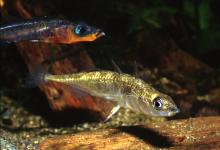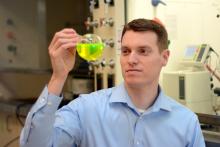News
-
Computer Science, Botany receive Canada Foundation for Innovation investments
March 16, 2016
UBC research into software development and food safety received funding this week from the Canada Foundation for Innovation’s John R Evans Leaders Fund. The John R. Evans Leaders Fund helps universities attract and retain researchers by providing funding for tools and laboratory equipment,… read more
-

Stewart Blusson Quantum Matter Institute launched with $11-million gift
March 10, 2016
Vancouver-based diamond pioneer and philanthropist Stewart Blusson and his wife, Marilyn, have donated $11 million to quantum materials research at UBC. In recognition of the gift, the Stewart Blusson Quantum Matter Institute has been named in honour of the geology alumnus (BSc ’60). &ldquo… read more
-

$2.5M boost to cutting-edge exploration geochemistry research at UBC
March 2, 2016
A new industry-government partnership that includes $1.25 million in funding from the Natural Sciences and Engineering Research Council of Canada (NSERC) will help launch a new chair in exploration geochemistry at the University of British Columbia. The five-year research program was created in… read more
-
Arctic ecosystem, biorefining research at UBC Science receive $1.2 million in NSERC funding
March 1, 2016
Six UBC projects have received $3.5 million in funding from the Natural Sciences and Engineering Research Council of Canada (NSERC). Among the projects tapped for the grants are ocenographer Philippe Tortell's Subarctic climate change research and chemist Harry Brumer's work on biotechnology… read more
-
Biological oceanographer Evgeny Pakhomov named director of UBC Institute for the Oceans and Fisheries
February 24, 2016
Biological and fisheries oceanographer Evgeny Pakhomov has been appointed director of the UBC Institute for the Oceans and Fisheries. The appointment is effective March 1, 2016 through June 30, 2019 with the possibility of an extension for an additional two years. Pakhomov's research focuses on… read more
-

Newly introduced species of fish speeds up evolution in BC lake
February 23, 2016
Just three years after crayfish were introduced to a BC lake, two species of fish that had existed in the lake for thousands of years were suddenly extinct. And the hybrid species that took their place has scientists fascinated. New research from UBC shows that when humans speed up the usually… read more
-
UBC chemist named to prestigious US fellowship
February 22, 2016
UBC chemical biologist Katherine Ryan, an expert in natural product molecules, has been named an Alfred P Sloan fellow. The fellowships honour early-career scientists and scholars whose achievements and potential identify them as rising stars. Ryan’s research investigates how complex… read more
-

Can community-based science save a way of life in Micronesia?
February 18, 2016
More than 600 islands dot the Western Pacific Ocean and form the Federated States of Micronesia. In total, they extend more than 1700 miles from west to east across one of the most biodiverse regions on Earth. UBC graduate student and marine biologist Sara Cannon has spent the last three years… read more
-

NSERC awardee is exploring new ways to store solar energy
February 10, 2016
UBC chemist and chemical engineer Curtis P. Berlinguette has been awarded a 2016 NSERC E.W.R. Steacie Memorial Fellowship for his research on solar energy conversion technologies. Berlinguette’s team is researching new catalysts which could convert sunlight into high-density fuels, such as… read more
-

Seven new CRCs appointed at UBC Science
February 9, 2016
The Faculty of Science welcomed seven new Canada Research Chairs today, an investment that will boost UBC’s research capacity in new materials, biodiversity, big data, health and artificial intelligence. The CRCs are part of 31 new or renewed Chairs worth $27 million at the University… read more